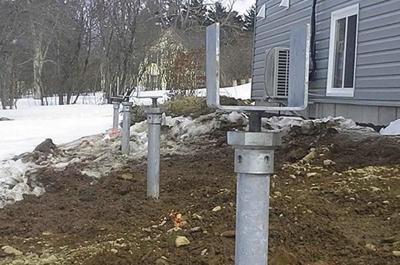
C:\Users\Webriser\Desktop\01-01-18\helical-piles.jpg
Helical piles are ground anchoring systems utilized for building deep foundations. These items are manufactured using different types of tubular hollow sections for the anchors shaft or pile. Installation of a helical pile is complex because it requires the movement of earth using hydraulic attachments. Installation of the helical piles are important because it adds to the longevity of a structure and a support system to a residence.
The helical pile is currently considered one of the most cost-effective types of foundation systems in the commercial and domestic construction industry. When considering the foundational support of a building, it is recommended that you look at helical piles. Not only are they durable, but they are also easy to install and will help save money. The majority of the helical piles are used in cases where a fast installation is required and the usage of this type of foundation contributes to its cost-effectiveness. Cost-efficiency of helical piles is as important as the cost-effectiveness of the item and contributes to its use in every major construction.
The durability is beneficial because helical piles were created to keep homes upright during different inclement weather conditions. This is one of the reasons why the helical piles are used in numerous constructions ranging from rails to lighthouses, roads, telecommunications, and other industries.
In addition to the abovementioned issues, there are further benefits to the use of helical piles including ease of installation, ease of access, shorter project times, and reduced cost. The system is also appropriate for both compressive loads and tensile loads; therefore, helical piles can be utilized for signs, masts, and retaining structures. Furthermore, helical piles are installed using hydraulic pressure which is beneficial because hydraulic pressure is unobtrusive.
The installation of this type of ground anchoring system needs to be conducted in an accurate manner and quickly using hand-held motors. To complete this task, the hydraulic pressure machinery is monitored closed and operated precisely to achieve the ideal capacity of the pier. Installers can be confidence that the required capacity is achieved in this way without any unnecessary material costs or the use of unnecessary angles of installation. Avoiding additional material costs is beneficial because it reduces the overall material costs.
There are numerous types of helical piles and helical pile combinations available making it less challenging for the installer to coordinate the load with the soil conditions. The anchoring system can offer long-term solutions for structural problems and these flexible foundation tools are highly beneficial. Firstly, it can offer a building increased strength with the screw piles installation. For example, if a retaining or basement wall is moving, the screw pile is ideal for your needs. Helical piles are useful as a preventative measure for tipping walls because helical pier installation can eliminate the movement of walls.
If the area being worked on requires additional efforts, it is essential that the provider is able to manage it. To ensure you have a reliable provider, it is recommended that you conduct research into the professional. Only work with experienced technicians who have a good professional reputation as they are reliable and efficient. This information can be obtained using online testimonials and reading through their portfolios.
Helical piles, ideally referred to as screw piles, helical anchors or screw anchors are basically a ground anchoring system utilized for forming deep foundations. They have an array of applications on both residential and commercial projects. In this post, we are going to look at the advantages steel helical piles offer in comparison to typical concrete foundations.
No Excavation
One of the best things about using helical piles for foundations is that there’s no need to excavate or cart away soil. That reduces the labor and time required to complete the project, which ultimately saves money.
Quick Installation
Steel screw piles foundations take less time to install compared to conventional concrete foundations.
Small Footprint and Less Vibration
Another benefit with helical piles is that you can use them in restricted areas like near buildings without having to take extra measures to keep them stable. Also, most of the helical steel pile installations do not go beyond 80bd. That means the vibration does not affect the nearing building's foundation and you won’t get noise complaints from the neighbors.
No Curing Time
Concrete foundations need time to dry for the project to continue, but that is not the case with helical pile foundations. This further reduces the construction period.
Flexible Designs
These piles are also specifically designed for your project, the soil you are building on and the available space. This makes them a better alternative to concrete foundations.
Environmentally Friendly
Steel screw piles have less impact on the surroundings when compares to their concrete counterparts.
Installation can be done during any Season
Unlike concrete, there’s no downtime during winter when it’s too cold for the substance to dry or cure properly. Helical anchors can be installed at any temperature and at any time of the year.
They can be installed on any Ground
It does not matter what type of ground you intend to build on, whether it is soft, rocky or even clay. These piles can create a solid foundation regardless of the location.


(0) comments
We welcome your comments
Log In
Post a comment as Guest
Keep it Clean. Please avoid obscene, vulgar, lewd, racist or sexually-oriented language.
PLEASE TURN OFF YOUR CAPS LOCK.
Don't Threaten. Threats of harming another person will not be tolerated.
Be Truthful. Don't knowingly lie about anyone or anything.
Be Nice. No racism, sexism or any sort of -ism that is degrading to another person.
Be Proactive. Use the 'Report' link on each comment to let us know of abusive posts.
Share with Us. We'd love to hear eyewitness accounts, the history behind an article.